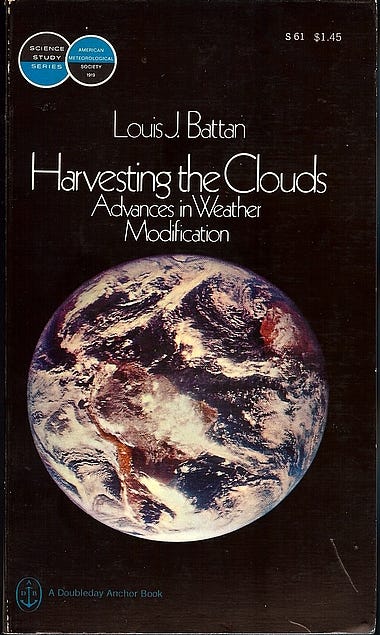In 2019, then-President Trump reportedly proposed “dropping nuclear bombs on hurricanes to disrupt their course.” It’s unclear whether the allegation is true—Trump denies having said it—but it’s not the first time such an idea has been proposed. The idea is suggested so frequently that the National Oceanic and Atmospheric Administration (NOAA) posted an FAQ debunking the idea.1
During each hurricane season, there always appear suggestions that one should simply use nuclear weapons to try and destroy the storms. Apart from the fact that this might not even alter the storm, this approach neglects the problem that the released radioactive fallout would fairly quickly move with the tradewinds to affect land areas and cause devastating environmental problems. Needless to say, this is not a good idea.
…The main difficulty with using explosives to modify hurricanes is the amount of energy required…The heat release is equivalent to a 10-megaton nuclear bomb exploding every 20 minutes. According to the 1993 World Almanac, the entire human race used energy at a rate of 1013 watts in 1990, a rate less than 20% of the power of a hurricane.
If giant nuclear bombs can’t stop hurricanes, perhaps something smaller can. Can nanotechnology control the weather?
Nanotech Weather Control?
In researching my nanotechnology book, I came across numerous conspiracy theories about secret cabals manipulating the weather through nanotechnology. One can find various claims about nanotechnology being used in “chemtrails” (contrails from aircraft believed to contain chemical or biological agents) that manipulate the weather and control the population. These theories suggest that nanoparticles are being sprayed into the atmosphere for nefarious purposes. Having worked in the field for over two decades and understanding the current state of the art, I know the technology is a LONG way from controlling the weather. However, there is just enough historical truth there for rumors like this to spread.
My introduction to the weather modification attempts came from the Science Study Series. With five titles to his name, meteorologist Louis J Battan authored more books in the series than anyone, including The Nature of Violent Storms and Harvesting the Clouds: Advances in Weather Modification. In the latter, Battan shares early attempts at controlling weather, including hurricanes:2
The first attempt to modify a hurricane cloud seeding was made by Irving Langmuir and his colleagues on General Electric's Project Cirrus. On October 13, 1947, a hurricane off the southeast coast of the United States was seeded with about two hundred pounds of Dry Ice. Following the seeding, the hurricane pursued an erratic and unexpected course. Instead of passing out to sea, it changed direction and moved inland.
At first glance, the idea of controlling hurricanes sounds crazy. To be clear, Langmuir was no crackpot. He was a renowned chemist who won the Noble Prize in 1932. However, the experiment itself was controversial. It was unclear whether the seeding caused the change in the hurricane's path or whether the storm would naturally have shifted course without intervention. The results were ultimately inconclusive, but Project Cirrus laid the groundwork for future weather modification research, including Project Stormfury.
Project Stormfury was a U.S. government initiative conducted from 1962 to 1983 aimed at weakening hurricanes through cloud seeding. Cloud seeding works by introducing micro or nanoparticles (such as silver iodide or dry ice) into clouds, which encourages the formation of ice crystals or raindrops. Under the right conditions, introducing these particles increases precipitation and alters weather patterns.
Scientists hypothesized that seeding the clouds of hurricanes with silver iodide would stimulate the formation of ice, thereby disrupting the inner structure of the storm and reducing its intensity. Despite some initial promising results, subsequent experiments showed no significant changes in hurricane behavior. The project faced challenges due to the natural variability of hurricanes and the difficulty in distinguishing between seeded and natural changes. Ultimately, Project Stormfury was discontinued, but it contributed valuable insights into the dynamics of hurricanes and cloud seeding techniques.
Today, researchers continue to study how nanotechnology might improve weather. Cloud seeding efforts may eventually help drought-stricken areas get much needed rain. According to Dr. Linda Zou, a professor of civil and environmental engineering at Khalifa University of Science and Technology,3
Through the advancement in nanotechnology and nanoscience, nowadays we are working to design and engineer cloud-seeding materials with optimal properties to ensure water vapor condensation will occur effectively and maximize the rainfall achieved…
As for controlling hurricanes, it remains difficult to run controlled experiments. One certainly doesn’t want to alter a hurricane adversely, e.g., increasing its intensity or directing it inland. One can only imagine the liability insurance needed to run such an experiment!4 Computer simulations can help us better understand the risks, but simulations can only go so far.5 In order to really understand any physical system you need to run experiments.
Should you be worried about evil government agencies controlling the weather? Probably not. Having been researched since the Cold War, weather modification has a fair amount of long-standing regulations already in place. For example, the Weather Modification Reporting Act of 1972,6
requires that all persons that conduct non-Federal weather modification activities within the United States or its territories report such activities to the U.S. Secretary of Commerce at least 10 days prior to and after undertaking the activities. Failure to report can result in fines of up to $10,000.
While it’s scary to think about what might go wrong, the potential of saving lives by reducing catastrophic weather events is certainly appealing. If we’re ever to achieve the ideal sci-fi future where you can push a button and turn off the rain, we’ll have to start somewhere. That likely means revisiting the type of small scale, low-risk, but nonetheless highly controversial weather modification experiments we started undertaking nearly 80 years ago. As we navigate the path forward, it’s crucial to balance bold experimentation with rigorous safety measures, ensuring that our pursuit of technological advancement serves humanity and safeguards our planet.
What are your thoughts? As climate change increasingly becomes a pressing issue, will we need to reignite weather modification research? Let me know in the comments, and don’t forget to subscribe and share!
https://web.archive.org/web/20160212064225/https://www.aoml.noaa.gov/hrd/tcfaq/C5c.html
For more info, you can check out Battan’s Harvesting the Clouds or this article at the Science History Institute You can also read the final Project Cirrus report: Langmuir, I., V. J. Schaefer, and B. Vonnegut. "Project Cirrus, Final Report." General Electric Research Laboratory, Schenectady, New York (1951).
https://www.technologyreview.com/2022/03/28/1048275/scientists-advance-cloud-seeding-capabilities-with-nanotechnology/
Harvard researchers have considered what the question of climate modification and insurance. See Horton, Joshua B., and David W. Keith. "Multilateral parametric climate risk insurance: a tool to facilitate agreement about deployment of solar geoengineering?." Climate Policy 19.7 (2019): 820-826. https://www.tandfonline.com/doi/abs/10.1080/14693062.2019.1607716
Hoffman, Ross N. "Controlling hurricanes." Scientific American 291.4 (2004): 68-75
https://libguides.library.noaa.gov/weather-climate/weather-modification-project-reports



